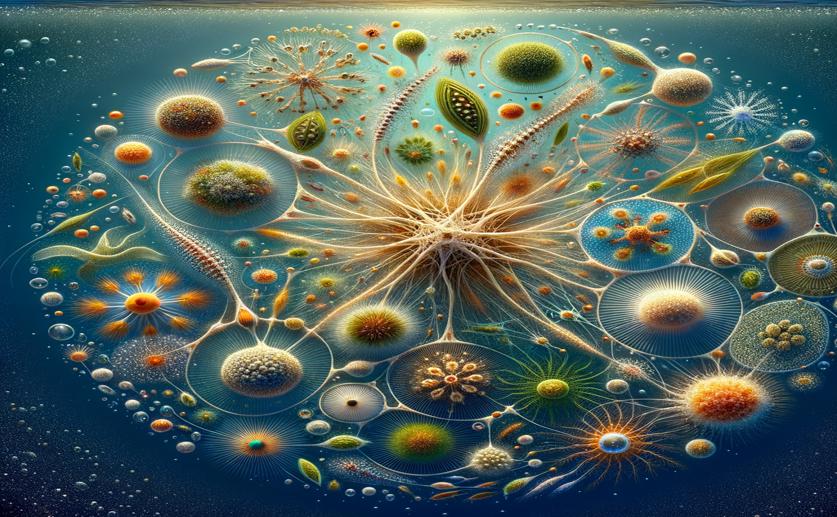Complex Breeding Patterns of Ocean Microalgae Explained

Image Source: Natural Science News, 2024
Key Findings
- In the Gulf of Naples, a study found that marine diatom populations change genetically over time
- A single diatom clone became dominant in 2013, but by 2017-2020, the population stabilized
- Sexual reproduction in diatoms promotes genetic diversity, crucial for their adaptability
Marine diatoms, microscopic algae that play a crucial role in ocean ecosystems, are not just drifting passively in the sea. These tiny organisms have complex life cycles and genetic structures that adapt to their environment. Scientists at the Stazione Zoologica Anton Dohrn have been meticulously studying these processes in the diatom Pseudo-nitzschia multistriata, not only because of its ecological importance but also due to its ability to produce domoic acid, a substance harmful to marine life and humans[1].
The recent study by researchers at the Stazione Zoologica Anton Dohrn delved into the genetic makeup of Pseudo-nitzschia multistriata populations in the Gulf of Naples over a span of 12 years. By examining the genetic 'fingerprints' of these diatoms, they aimed to understand how populations change over time and what factors might influence these changes.
Diatoms like Pseudo-nitzschia multistriata reproduce both sexually and asexually, contributing to their genetic diversity. This diversity is important for their survival, as it allows them to adapt to changing environments[2][3]. The study found that these diatoms can undergo a clonal expansion, a period where one genetic type becomes dominant. This was observed in a bloom in 2013 when one particular clone expanded dramatically. However, in the years following, from 2017 to 2020, the population's genetic structure appeared more stable.
One of the groundbreaking aspects of this research was the identification of a mating type determination gene in Pseudo-nitzschia multistriata, which allows scientists to understand the sexual reproduction patterns of these diatoms[2]. The study revealed that the mating types were generally balanced, except during certain events like the clonal bloom of 2013. This balance is crucial because it suggests that sexual reproduction is occurring, which promotes genetic diversity and homogenization.
The researchers used two methods to analyze the genetic structure: microsatellite fingerprinting of isolated strains and a novel approach called Microsatellite Pool-seq Barcoding, which sequences DNA from natural samples. Both methods confirmed the clonal expansion and subsequent stabilization of the population's genetic structure.
The findings from this study are significant because they suggest that the genetic diversity and population dynamics of Pseudo-nitzschia multistriata are influenced by cells from deeper water layers, which can rise and initiate blooms. The occasional dominance of a single clone, while temporary, can have implications for the species' adaptability and the ecosystem's health, especially when considering the production of domoic acid.
Previous studies have shown that diatoms can rapidly accumulate genetic changes even within clonally propagated cultures, leading to a rich genetic micro-diversity[4]. This plasticity in their genetic makeup may help explain how diatoms have become one of the most successful groups of microalgae in the ocean. Furthermore, the study of Pseudo-nitzschia multistriata populations from different regions has contributed to our understanding of how these diatoms can interbreed and maintain genetic diversity despite being geographically separated[5].
The dynamic nature of Pseudo-nitzschia multistriata's genetic landscape, as revealed by this long-term study, underscores the complexity of these microscopic organisms. The work done by the Stazione Zoologica Anton Dohrn not only contributes to our basic understanding of diatom biology but also has practical implications for monitoring and managing harmful algal blooms. By unraveling the genetic intricacies of these blooms, scientists are better equipped to predict and mitigate their impact on marine ecosystems and human health.
GeneticsEcologyMarine Biology
References
Main Study
1) Multiannual patterns of genetic structure and mating type ratios highlight the complex bloom dynamics of a marine planktonic diatom.
Published 12th March, 2024
Journal: Scientific reports
Issue: Vol 14, Issue 1, Mar 2024
Related Studies
Related Articles





 7th March, 2024 | Jenn Hoskins
7th March, 2024 | Jenn Hoskins